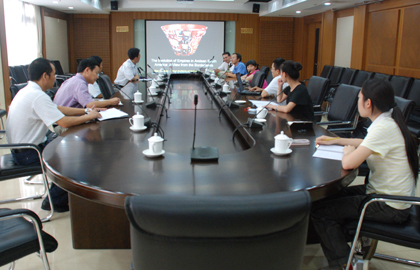UCLA's Dr. Ran Boytner Gives Lecture at the Institute of Archaeology
On the afternoon of July 31st, 2009, Dr. Ran Boytner from the University of California, Los Angeles (UCLA), visited the Institute of Archaeology (CASS) to give a lecture entitled "The Evolution of Empires in Andean South America : A View from the Borderlands". Deputy Director Chen Xingcan presided over the lecture with Zhang Liangren in the role of interpreter. Students and researchers from the Institute of Archaeology, Peking University and the University of Science and Technology of China attended the lecture and took part in the discussion with Dr. Boytner.

Dr. Boytner began his lecture by giving an introduction to the geographic environment of the Andes mountains and the development of the archaeological work conducted in the region. He then went on to talk about the important archaeological research and discoveries made regarding the various polities which inhabited the Andes region between 600 and 1000 AD.
The western slopes of the Andes mountains have a dry, arid climate and scholars once thought that the region was unfit for human habitation. However, archaeological discoveries have since revealed that the region was home to a number of centralized polities between 600 and 1000 AD. Excavation work in the region has suffered numerous setbacks due to the absence of a written history, the disturbance of indigenous relics caused by frequent ethnological surveys in recent history and discontinuities to the historical record caused by the spread of Spanish colonialism. As a result, archaeological research in the area remains relatively underdeveloped.

Dr Boytner went on to talk about the excavation and research conducted at the Millo II site and described the shifting politics of the area between 600 and 1000 AD between three civilizations, the Moche, the Huari and the Tiwanaku, which inhabited the north, central and southern regions of the Andes respectively. The archaeological investigation into the political environment of that era focussed on four main topics : the rise and fall of each culture as reflected in the archaeological record; the nature of the three polities; mutual relations between the polities; and territorial issues.
Due to political reasons and the slow development of archaeological research in the region,there is very little reference material to rely on and an accurate chronology cannot be established until C-14 dating has been conducted on the various sites in the area. Scholars are still in disagreement over the nature of the three polities and the issue of whether they had already entered the national phase is still a subject of debate. Two of the excavation sites located outside the Millo II site have revealed pottery and architectural styles from various cultures. Dr Boynter suggests that Millo II may have been a point of cultural exchange between the three polities and that the findings show that the three civilizations were contemporaneous. He hopes to conduct further research in the area and determine when each polity reached the height of its power.
After the lecture, Deputy Director Chen Xingcan accompanied Dr. Boytner on a visit to the Institute of Archaeology's exhibition hall. (Translated by Kelly McGuire)

